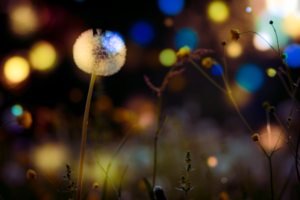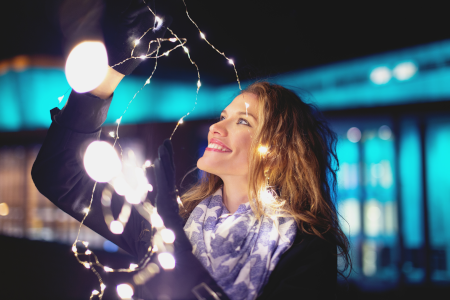Bokeh is the out-of-focus parts of a photograph in either the background or the foreground to create an aesthetic effect. A lot of photographers use bokeh to draw the eye to their subjects, but it can be used for so much more than that. In this article, we’ll talk about the history of bokeh and how to use it creatively to compose spectacular photos.
Why Is It Called ‘Bokeh’?
‘Bokeh’ comes from the Japanese ‘boke’ which means ‘blur’. So why do we say ‘bokeh’ instead of ‘boke’? Mostly because English speakers have a hard time pronouncing it right. If this is the first time you’ve seen ‘boke’, you probably want to pronounce it in a way that rhymes with ‘spoke’. In Japanese it would be pronounced like ‘bow-ke’ (‘ke’ as in ‘Kent’). Turns out, English speakers are better at guessing the pronunciation when it’s spelled ‘bokeh’.
Why Don’t We Call ‘Bokeh’ Blur?
Some sources credit the term ‘bokeh’ to Mike Johnson in the May/June 1997 issue of Photography Magazine but Johnson likely learned the term from John Kennerdell and Oren Grad – both of whom studied Japanese photography techniques. So we kinda are calling it ‘blur’. We’re just doing it in the language that introduced us to the technique.
Why Would You Want Bokeh In Your Photographs?
A lot of us on the Mirrorless Camera blog team wanted to take pictures that captured everything in sharp detail when we first started out, but that often resulted in boring photos. Part of the art of photography is to capture the emotion or awe around the moment rather than just arbitrarily freezing time. Bokeh can help you do that. Here’s how:
Focus on the subject
Try something real quick. Look up and focus on something in the room. Now, without moving your eyes, try to look at something else. Kinda blurry, isn’t it? That’s the way we see. Not everything is in focus when you look at something. Bokeh can help recreate that phenomenon in your photography and draw your eyes to the subject. This technique is commonly used in portrait photography.

Focus on a beautiful background
Sometimes the most interesting spot of an image is the colors going on in the background. Take the image below:

The bokeh in the background makes it easy to forget that the subject in focus is just a weed. The next time you see interesting lights or colors, let your eyes go out of focus and see if some background bokeh could be used to make a more interesting photo. It’s a cool way to play with colors.
Play With The Foreground
Bokeh doesn’t have to be behind your subject. Sometimes it can be in front of it. Think about a person standing behind a window with colorful neon reflecting off of it. Foreground bokeh can capture the colors of the neon while keeping your subject in focus. Or take the image below, for example:

Notice how the bokeh on the lights add a sense of magic to the image. For us, it evoked feelings of a Christmas holiday or a winter party. In reality – it’s just a woman playing with a string of lights. It’s pretty amazing what a little bokeh can do.
How To Get Bokeh In Your Photographs
Use The Right Lens
You’ll want a fast lens to get good bokeh in your photos. A ‘fast lens’ means a lens that has a large aperture – at least f/2.8. An aperture of f/1.8 would be even better (remember that the lower f means a bigger aperture). A large aperture means a shallower depth of field which is exactly what you want for good bokeh.
Another thing to consider is the number of blades your aperture has. The more blades, the rounder lights will look when you use bokeh. That’s not to say that rounder is better. Some photographers prefer polygons to soft orbs of light. It’s an artistic choice for you to make.
-
Kamlan 50 mm F1.1 APS-C Large Aperture Manual Fixed Focus Lens, Standard Prime Lens
Camera Lenses $99.99Rated 0 out of 5 -
Kamlan 50mm F1.1 APS-C Large Aperture Manual Focus Lens Standard Lens for Mirrorless Cameras (Micro 4/3 Mount)
Camera Lenses $159.00Rated 0 out of 5 -
Krorux 35mm F1.6 Manual Focus Camera Lens Compatible with Fujifilm X Mount Mirrorless Cameras
Camera Lenses $39.99Rated 0 out of 5
Use The Right Camera Settings
Since aperture setting is how you get good bokeh pictures, you’ll want your camera to be in Aperture Priority mode – sometimes called AV mode. With aperture priority, you choose the aperture you want and your camera will automatically select the appropriate speed for your picture. If you want to control both, you can go to full manual mode.
Fix It In Post
Didn’t have the right lens when you took your picture? Do you have a picture that you think would look better if it had the right bokeh? Then it’s time to leverage one of the greatest advantages of mirrorless digital photography – post production. You can use a program like PhotoShop or Gimp (it’s like PhotoShop, but free) to add bokeh to your photos.
Conclusion
Bokeh is simple to do and can add a lot of interest to your photographs. It allows you to focus on your subject and play with color. It’s something you should consider when composing any photo to see if bokeh can enhance the emotion of what you’re trying to convey.








